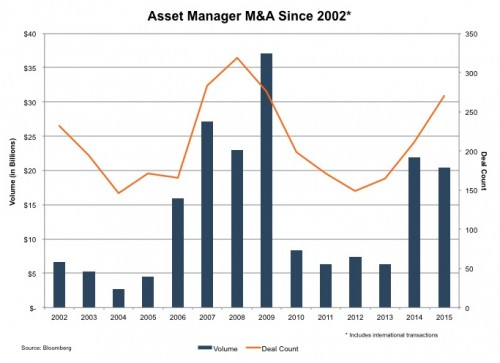Stagnating Growth May Trigger More Dealmaking for Asset Managers
Some of our recent musings on mutual fund outflows and multiple contraction may actually have positive implications for RIA deal-making in 2016 and beyond. The maturation of the mutual fund industry and active fund managers will likely spur consolidation and buying opportunities for those looking to add scale. With valuations and market caps down over the last eighteen months or so, the affordability index has gotten a lot better for many of these businesses.
Expectations for slower growth (reflected in lower multiples) could be another driver of M&A activity, as RIAs look to other asset managers to build or replace AUM depleted by outflows and market movements. If organic growth opportunities are truly stalling, acquisitions are a viable means to offset falling management fees and collect market share for those that can afford to do so. Rising cap rates should also help, as the embedded return on investment improves with lower multiples.
The recent gains in volatility should have a more nuanced effect on the pace of acquisitions. Prospective buyers might be spooked by the sector’s vulnerability to investor sentiment as a high-beta business. Alternatively, the relatively low levels of leverage and balance sheet risk might make it more resilient to credit crunches or changes in capital requirements.
For whatever the reason, the past few weeks have witnessed a few major transactions in the space, including State Street’s $485 million purchase of GE Asset Management and Bank of Singapore’s $320 million acquisition of Barclays wealth management operations in the Far East. These deals, coupled with the Kanaly Trust / Mercer Advisors (no relation) merger indicate a growing appetite for larger deals in the last month or so.
On balance, 2016 could be a record year for sector dealmaking both in terms of deal count and collective volume. While this may be a stretch given the number of distressed sales during the financial crisis, a continuation of the recent uptick is certainly achievable.
We believe the backlog of available deals remains fairly robust given the four year pause in transactions from 2009 to 2013 and the aging demographics of many investment management firms. Still, we acknowledge that the decline in transaction activity following the financial crisis of 2008 and 2009 could be indicative of what another bear market could do to M&A trends when the dust settles and AUM has cratered.
 RIA Valuation Insights
RIA Valuation Insights 







